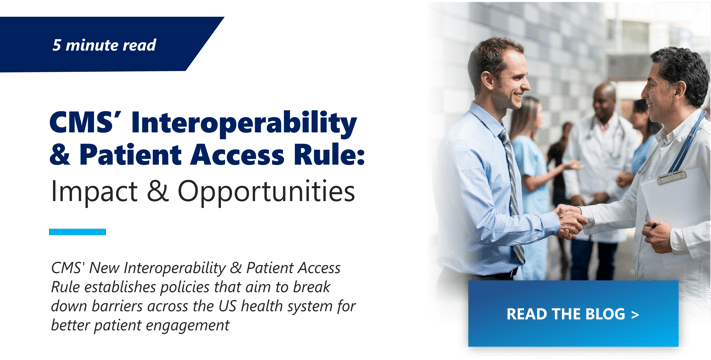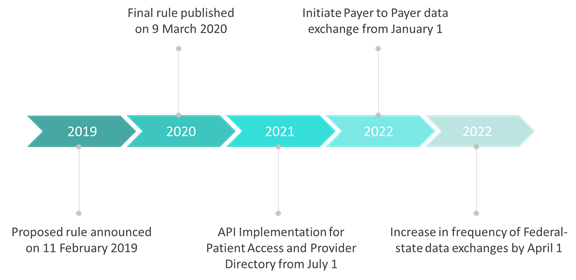
CMS released the much-awaited Interoperability & Patient Access Rule in early March this year. This rule establishes policies that aim to break down barriers in the health system across the US for better patient engagement.
CMS had proposed the Interoperability & Patient Access Rule to support regulations of the MyHealthEData initiative and 21st Century Cures Act with an implementation timeline. This resulted in numerous requests from the healthcare industry, especially from the payer community, which demanded for the rule to be implemented in a phased manner. This was well received by CMS and timelines have been set accordingly given that technological advancements and security of data exchange need to be taken into consideration.
The rule promises to enable better patient access to their health information, improve interoperability and drive innovation, while reducing burden on payers and providers. Patients can now be aware of their health information for better care and improved patient outcomes. With data being available conveniently and securely among payers, providers and patients, CMS hopes to achieve real coordinated care, improved health outcomes and reduced costs.
The new rule states seven policies that will improve access to health information and move the healthcare ecosystem toward greater interoperability. A summary of the new policies and its possible impact on payers and providers are as follows:
Impact on Payers
- Patient Access API - Claims & Encounter: Make member health information available to them through APIs connecting third party software apps
- Provider Directory API: Maintain and publish provider directory data through APIs with latest updates
- Payer to Payer Data Exchange: Exchange data set (of up to five years) to another plan that currently covers the enrollee
- Improving the Dually Eligible Experience by Increasing the Frequency of Federal-State Data Exchanges: From weekly or monthly, to daily exchange
Impact on Providers
- Public Reporting and Information Blocking: CMS will start publishing a list of providers, clinicians, etc. who act as information blockers and also a list based on provider performance to promote the interoperability program under MIPS
- Digital Contact Information: CMS in the later part of 2020 to publicly start reporting providers who do not list or update their digital contact information in the National Plan and Provider Enumeration System (NPPES)
- Admission, Discharge and Transfer (ADT) Event Notifications: Standardized patient ADT event messaging system between health systems to improve care coordination
New Rule Timeline

Key Rule Requirements and Activities for Payers
|
Rule Requirements |
Activities to Undertake |
|
|
|
|
|
|
|
The COVID-19 Challenge
As the impact of COVID-19 is devastating to many market segments; the US healthcare sector is no exception. Healthcare payers in the US, including health insurance companies, risk-bearing healthcare providers, self-funded employers and others are facing peak levels of uncertainty.
Experts say plans are being put forth on how to manage COVID-19 within the US, which also involves IT departments of healthcare organizations. Smaller provider and payer organizations will be particularly challenged as they don’t have comprehensive IT or financial functions.
Acknowledging the impact of COVID-19 within the US, and especially on hospitals, including psychiatric hospitals and critical access hospitals, CMS has decided to extend the implementation timeline for the admission, discharge, and transfer (ADT) notification Conditions of Participation (CoPs) by an additional six months. However, we expected payer & provider organizations to be well prepared since the Interoperability and Patient Access Rule was proposed last year.
Summary
The new CMS rule promises to help payers achieve seamless flow of health information to patients and providers, with stronger privacy and security measures to protect personal health information. CMS also plans to implement more advanced data sharing standards to improve and simplify the overall healthcare experience, where HL7 Fast Healthcare Interoperability Resources (FHIR®) is slated to play a key role for faster implementation, speed to market and better provider and member engagement.


